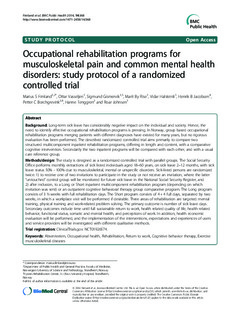Occupational rehabilitation programs for musculoskeletal pain and common mental health disorders: Study protocol of a randomized controlled trial
Fimland, Marius Steiro; Vasseljen, Ottar; Gismervik, Sigmund Østgård; Rise, Marit By; Halsteinli, Vidar; Jacobsen, Henrik Børsting; Borchgrevink, Petter Chr.; Tenggren, Hanne; Johnsen, Roar
Journal article, Peer reviewed
Permanent lenke
http://hdl.handle.net/11250/302337Utgivelsesdato
2014Metadata
Vis full innførselSamlinger
Sammendrag
Background: Long-term sick leave has considerably negative impact on the individual and society. Hence, the
need to identify effective occupational rehabilitation programs is pressing. In Norway, group based occupational
rehabilitation programs merging patients with different diagnoses have existed for many years, but no rigorous
evaluation has been performed. The described randomized controlled trial aims primarily to compare two
structured multicomponent inpatient rehabilitation programs, differing in length and content, with a comparative
cognitive intervention. Secondarily the two inpatient programs will be compared with each other, and with a usual
care reference group.
Methods/design: The study is designed as a randomized controlled trial with parallel groups. The Social Security
Office performs monthly extractions of sick listed individuals aged 18–60 years, on sick leave 2–12 months, with sick
leave status 50% - 100% due to musculoskeletal, mental or unspecific disorders. Sick-listed persons are randomized
twice: 1) to receive one of two invitations to participate in the study or not receive an invitation, where the latter
“untouched” control group will be monitored for future sick leave in the National Social Security Register, and
2) after inclusion, to a Long or Short inpatient multicomponent rehabilitation program (depending on which
invitation was sent) or an outpatient cognitive behavioral therapy group comparative program. The Long program
consists of 3 ½ weeks with full rehabilitation days. The Short program consists of 4 + 4 full days, separated by two
weeks, in which a workplace visit will be performed if desirable. Three areas of rehabilitation are targeted: mental
training, physical training and work-related problem solving. The primary outcome is number of sick leave days.
Secondary outcomes include time until full sustainable return to work, health related quality of life, health related
behavior, functional status, somatic and mental health, and perceptions of work. In addition, health economic
evaluation will be performed, and the implementation of the interventions, expectations and experiences of users
and service providers will be investigated with different qualitative methods.
